-
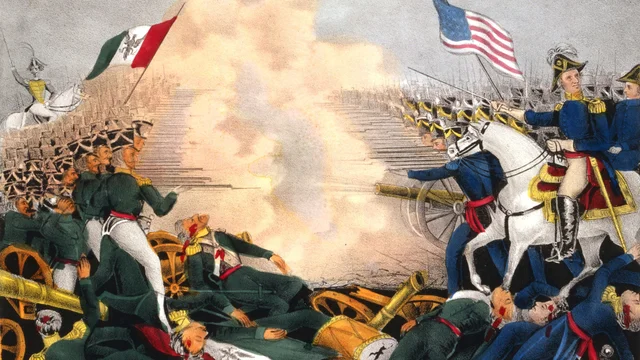 After border issues in Texas, the United States declared war on Mexico. Due to armed strife brought on by President Polk's expansionist policy, the United States gained a substantial amount of territory, including what would eventually become California, Arizona, and New Mexico. Sectional tensions were heightened and the groundwork for future political crises was laid as these acquisitions rekindled discussions over the spread of slavery into new areas. (McPherson, 51)
After border issues in Texas, the United States declared war on Mexico. Due to armed strife brought on by President Polk's expansionist policy, the United States gained a substantial amount of territory, including what would eventually become California, Arizona, and New Mexico. Sectional tensions were heightened and the groundwork for future political crises was laid as these acquisitions rekindled discussions over the spread of slavery into new areas. (McPherson, 51) -
 Congressman David Wilmot of Pennsylvania suggested outlawing slavery in any land that was taken from Mexico. The proviso's introduction stoked intense discussions about the future of slavery, further dividing Northern and Southern lawmakers, even though it failed in the Senate. It was seen as an existential threat by Southerners and as opposition to the spread of slavery by Northerners. An important turning point in the widening gap was this political crisis. (Varon, 90)
Congressman David Wilmot of Pennsylvania suggested outlawing slavery in any land that was taken from Mexico. The proviso's introduction stoked intense discussions about the future of slavery, further dividing Northern and Southern lawmakers, even though it failed in the Senate. It was seen as an existential threat by Southerners and as opposition to the spread of slavery by Northerners. An important turning point in the widening gap was this political crisis. (Varon, 90) -
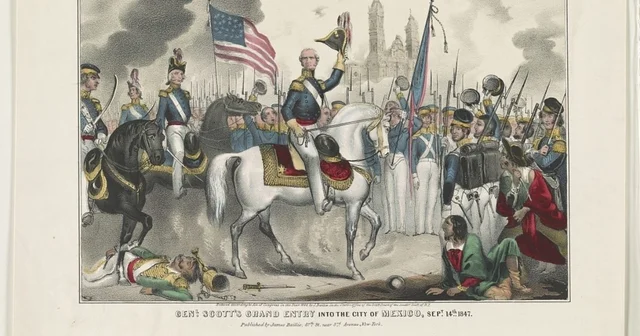 This treaty gave the United States extensive lands in the West and put an end to the Mexican-American War. Bitter arguments over whether slavery should spread were reignited by these new territories, which fueled sectionalism. New disputes were brought to light by California's subsequent attempt to become a free state, underscoring the failure of previous agreements to keep the country united. (McPherson, 67)
This treaty gave the United States extensive lands in the West and put an end to the Mexican-American War. Bitter arguments over whether slavery should spread were reignited by these new territories, which fueled sectionalism. New disputes were brought to light by California's subsequent attempt to become a free state, underscoring the failure of previous agreements to keep the country united. (McPherson, 67) -
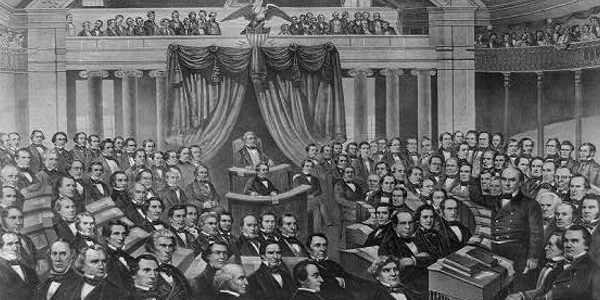 Southern elites gathered to talk about possible restraints on the spread of slavery as well as how they would respond to the burgeoning anti-slavery movement. The conference emphasized Southern concerns about their position in the Union, even if it refrained from advocating for imminent secession. The secessionist conventions that would take place ten years later were modeled after this assembly, which demonstrated the South's growing estrangement. (Varon 122)
Southern elites gathered to talk about possible restraints on the spread of slavery as well as how they would respond to the burgeoning anti-slavery movement. The conference emphasized Southern concerns about their position in the Union, even if it refrained from advocating for imminent secession. The secessionist conventions that would take place ten years later were modeled after this assembly, which demonstrated the South's growing estrangement. (Varon 122) -
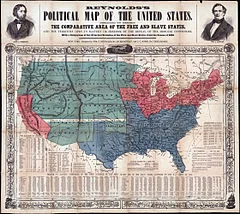 Following territorial gains from the Mexican-American War, the goal of this legislative package was to balance slave and free states. The Fugitive Slave Act, which infuriated Northerners by ordering them to repatriate runaway slaves, and California's admission as a free state were important clauses. The deal increased sectional divisions while delaying war, demonstrating the growing incompatibility of the two areas' future aspirations for America. (McPherson, 95)
Following territorial gains from the Mexican-American War, the goal of this legislative package was to balance slave and free states. The Fugitive Slave Act, which infuriated Northerners by ordering them to repatriate runaway slaves, and California's admission as a free state were important clauses. The deal increased sectional divisions while delaying war, demonstrating the growing incompatibility of the two areas' future aspirations for America. (McPherson, 95) -
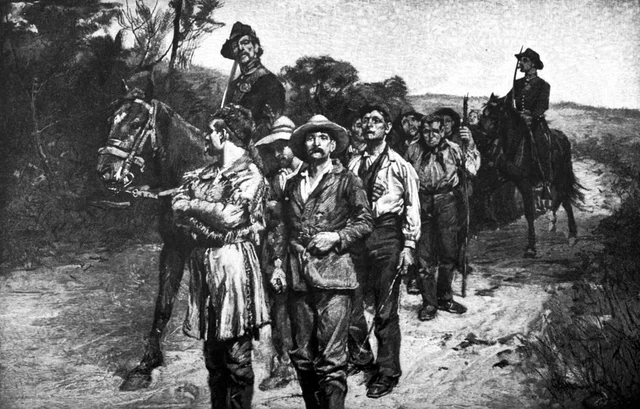 The Missouri Compromise was overturned when Stephen Douglas introduced the Kansas-Nebraska Act, which gave settlers a say in whether or not slavery would be legalized. As a result, Kansas saw bloody conflicts between those that supported and opposed slavery, which became known as "Bleeding Kansas." The measure fueled abolitionists, further split the country, and helped the Republican Party come into being. (McPherson, 115).
The Missouri Compromise was overturned when Stephen Douglas introduced the Kansas-Nebraska Act, which gave settlers a say in whether or not slavery would be legalized. As a result, Kansas saw bloody conflicts between those that supported and opposed slavery, which became known as "Bleeding Kansas." The measure fueled abolitionists, further split the country, and helped the Republican Party come into being. (McPherson, 115). -
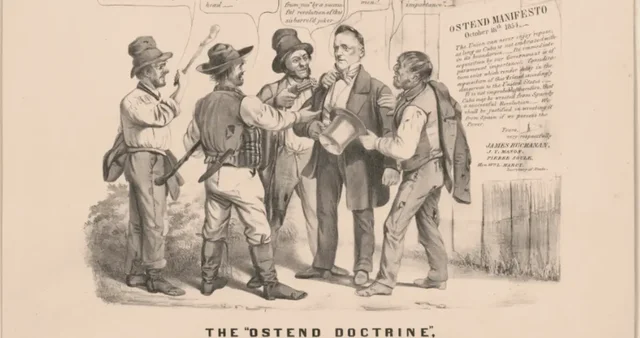 This classified memo laid forth a strategy for the United States to expand slavery in Cuba by either purchasing it or annexing it by force. When it was released, it exposed Southern officials' plans to take slavery outside of the United States and incited popular fury in the North. The outcry exposed the growing global reach of the slavery argument and damaged the reputation of pro-slavery activists. (Varon, 145)
This classified memo laid forth a strategy for the United States to expand slavery in Cuba by either purchasing it or annexing it by force. When it was released, it exposed Southern officials' plans to take slavery outside of the United States and incited popular fury in the North. The outcry exposed the growing global reach of the slavery argument and damaged the reputation of pro-slavery activists. (Varon, 145) -
 As pro-slavery and anti-slavery settlers fought over the future of the region, violence broke out in Kansas. These conflicts, which included raids, killings, and property devastation, served as a miniature version of the upcoming Civil War. The nation's fundamental differences and impending conflict were highlighted by the failure of popular sovereignty as a solution to slavery. (McPherson, 123)
As pro-slavery and anti-slavery settlers fought over the future of the region, violence broke out in Kansas. These conflicts, which included raids, killings, and property devastation, served as a miniature version of the upcoming Civil War. The nation's fundamental differences and impending conflict were highlighted by the failure of popular sovereignty as a solution to slavery. (McPherson, 123) -
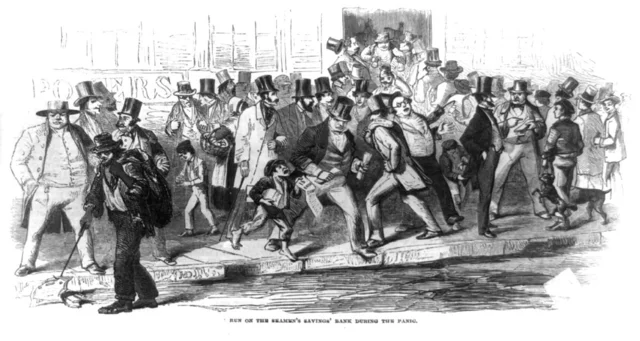 Northern industries were particularly hard hit by a financial crisis brought on by the failure of multiple banks and a drop in the market for American products abroad. Many Southerners felt they were economically better since the South, with its economy centered on cotton, was less impacted. Sectional divisions widened as a result of Southerners' growing confidence in their system's ability to function without Northern assistance. (Varon, 161.)
Northern industries were particularly hard hit by a financial crisis brought on by the failure of multiple banks and a drop in the market for American products abroad. Many Southerners felt they were economically better since the South, with its economy centered on cotton, was less impacted. Sectional divisions widened as a result of Southerners' growing confidence in their system's ability to function without Northern assistance. (Varon, 161.) -
 In an attempt to spark a mass slave revolt, John Brown staged an armed raid on the Harpers Ferry government armory. Brown was apprehended after the raid failed, but his trial and execution turned him into a monster in the South and a martyr in the North. The raid pushed the country closer to war by intensifying Southern anxieties about abolitionist assault. (McPherson, 143)
In an attempt to spark a mass slave revolt, John Brown staged an armed raid on the Harpers Ferry government armory. Brown was apprehended after the raid failed, but his trial and execution turned him into a monster in the South and a martyr in the North. The raid pushed the country closer to war by intensifying Southern anxieties about abolitionist assault. (McPherson, 143)